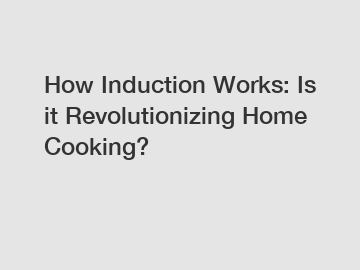Have you heard about induction cooking and wondered what all the fuss is about? This innovative technology is revolutionizing the way we cook in our homes, offering a faster, more efficient, and precise way to prepare meals. In this blog post, we will explore how induction works and discuss whether it is truly revolutionizing home cooking.
Induction cooking uses electromagnetic energy to heat cookware directly, rather than relying on radiant heat from a flame or electric element. This technology involves a coil of copper wire under the surface of a ceramic cooktop that produces a high-frequency electromagnetic field. When a compatible piece of cookware is placed on the cooktop, the field induces a current in the pot or pan, which in turn heats the cookware and its contents.
One of the key advantages of induction cooking is its speed and efficiency. Because the heat is generated directly in the cookware, rather than transferring from a heating element to the cookware, induction cooktops can heat up much faster than traditional gas or electric stovetops. This means you can boil water, sear meat, or sauté vegetables in a fraction of the time it would take on a conventional stove.

In addition to its speed, induction cooking is also incredibly precise. Unlike gas or electric stovetops, which can have hot spots or uneven heat distribution, induction cooktops heat evenly across the entire surface of the cookware. This precise control allows for more consistent cooking results and reduces the likelihood of burning or undercooking food.
Another benefit of induction cooking is its safety features. Because induction cooktops only heat the cookware, rather than the surface of the cooktop itself, they remain cool to the touch during cooking. This reduces the risk of burns or accidental fires, making them a safer option for households with children or pets.
Induction cooktops are also highly energy efficient. Because they heat up so quickly and cook food more evenly, they require less energy to operate than traditional stovetops. This can result in lower electricity bills and reduced environmental impact, making them a more sustainable choice for eco-conscious consumers.
Despite all of these advantages, there are some downsides to induction cooking. One of the main drawbacks is the cost of induction cooktops, which can be significantly higher than traditional gas or electric stoves. Additionally, induction cookware can be more expensive than regular pots and pans, as they need to be made from ferrous materials like cast iron or stainless steel to work effectively on an induction cooktop.
Another potential downside is the learning curve associated with induction cooking. Because the heat is so precise and instantaneous, it can take some time to get used to cooking on an induction cooktop and adjust your cooking techniques accordingly. However, once you get the hang of it, many people find that induction cooking offers unparalleled control and convenience in the kitchen.
In conclusion, induction cooking is indeed revolutionizing home cooking with its speed, precision, safety, and energy efficiency. While there may be some upfront costs and a learning curve associated with this technology, the benefits far outweigh the drawbacks for many home cooks. If you are considering upgrading your kitchen appliances or are simply curious about trying out a new way of cooking, induction technology is definitely worth exploring. Give it a try and see for yourself how induction cooking can transform your culinary experience.
If you want to learn more, please visit our website induction heater industrial, induction hardening machine price, induction hardening machine.



Comments
Please Join Us to post.
0